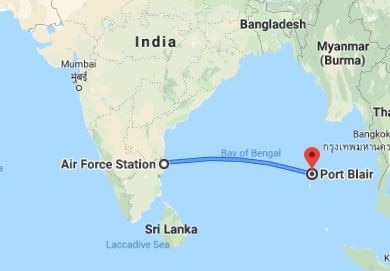Last Time An Air Force AN-32 Aircraft Went Missing, It Was Never Found

An An-32 with 13 people on-board went missing over the Northeast on Monday. In July 2016, an An-32 aircraft went missing over the Bay of Bengal. The IAF called off the search in September 2016 and presumed all on-board had died
An Indian Air Force transport aircraft went missing over the Northeast on Monday afternoon. The aircraft, which was flying 13 people from Assam to an advance landing ground in Arunachal, was a Antonov An-32.
The An-32's disappearance over the Northeast brings back ugly memories of a similar disappearance from 2016, when an Indian Air Force transport plane went missing over the Bay of Bengal. That plane was an Antonov An-32 as well. It was never found.
On the morning of July 22, 2016, an Indian Air Force Antonov An-32, with tail/registration number K2743, from the Tambaram Air Force Station in Chennai. There 29 people, including crew, on-board the transport aircraft, which was on a weekly trip to Port Blair in Andaman and Nicobar Islands.
The plane took off from Chennai at around 8 am and was supposed to land at INS Utkrosh, an Indian naval air station, in Port Blair.
Shortly after takeoff, the aircraft lost all contact and disappeared off radars while it was over the Bay of Bengal.
 The disappearance promoted the armed forces to launch what later became India's largest search and rescue mission for a plane missing over sea.
The disappearance promoted the armed forces to launch what later became India's largest search and rescue mission for a plane missing over sea.
The An-32 that disappeared over Bay of Bengal was flying from Chennai to Port Blair (Photo: Google Maps)
Several aircraft, ships, a submarine and even satellites were deployed to find the missing An-32.
Immediately after the An-32 went missing over the Bay of Bengal, the Indian Navy deployed two of its surveillance aircraft, four ships and a submarine to find the missing air force plane. The Indian Air Force pressed into service three aircraft to scan the Bay of Bengal for possible debris.
By Day 3, nearly 20 Indian Navy and Coast Guard ships and around eight aircraft were reportedly involved in the massive search and rescue operation. The Indian Space Research Organisation (ISRO) too pitched in, using one of its radar imaging satellites to locate the missing An-32.
The days, however, slipped by without any sign of the ill-fated An-32. The Indian Air Force even approached international agencies for help and requested the United States to use its satellites to look over the aircraft.

A map of search operations that were launched in the immediate aftermath of the An-32 going missing on July 22, 2016 (Photo: Twitter/ShivAroor)
What was frustrating the search efforts was the fact that the An-32 that disappeared over Bay of Bengal did not have any underwater locator beacons installed. These beacons emit a radio signal when an aircraft gets submerged at sea. The signals are then picked up by submarines or ships, helping located a plane that may have crashed at sea.
What the An-32 that disappeared in 2016 had were an emergency locator transmitter and personal locator beacons on the rubber boats and life vests present on the aircraft. However, these devices did not have the capability to communicate underwater.
And so it was that the An-32 K2743, which was quickly becoming India's MH-370 (MH-370 was a Malaysia Airlines passenger jet that disappeared over the Indian Ocean in March 2014. It was never found.), remained missing out at sea.
On September 15, the Indian Air Force finally threw in the towel. Writing to the family members of the 29 people onboard the An-32 K2743, the air force said it had failed to locate the missing aircraft and was left with no option but to declare those on-board "presumed dead".

A map of the search efforts for An-32 on August 12, 2016
In the letter, the Indian Air Force underlined the massiveness of the search and rescue operation undertaken to find the missing aircraft.
More than 200 air sorties were carried out, scouring an area of 2,17,800 square nautical miles (that's around 7.5 lakh square kilometres or around six times the area of Delhi). Ships from the Indian Navy and Coast Guard searched nearly 28,000 square nautical miles of sea while the eastern coast too was searched for possible debris washing ashore.
All these efforts, however, came to nought and the Indian Air Force was forced to presume that An-32 K2743 had crashed at sea, killing all on-board.
Does a similar fate await the 13 people on-board the An-32 that disappeared over the Northeast on Monday? We hope not.



No comments:
Post a Comment